Clinical Perinatal Software Market Size
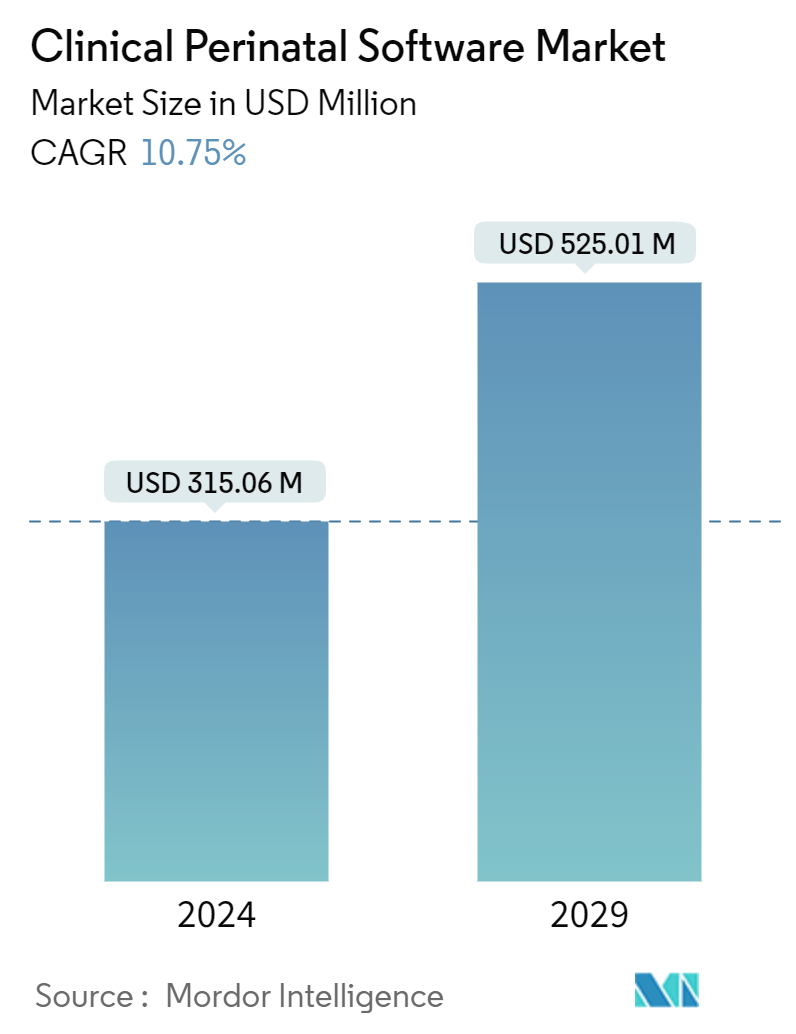
| Study Period | 2019 - 2029 |
| Market Size (2024) | USD 315.06 Million |
| Market Size (2029) | USD 525.01 Million |
| CAGR (2024 - 2029) | 10.75 % |
| Fastest Growing Market | Asia Pacific |
| Largest Market | North America |
Major Players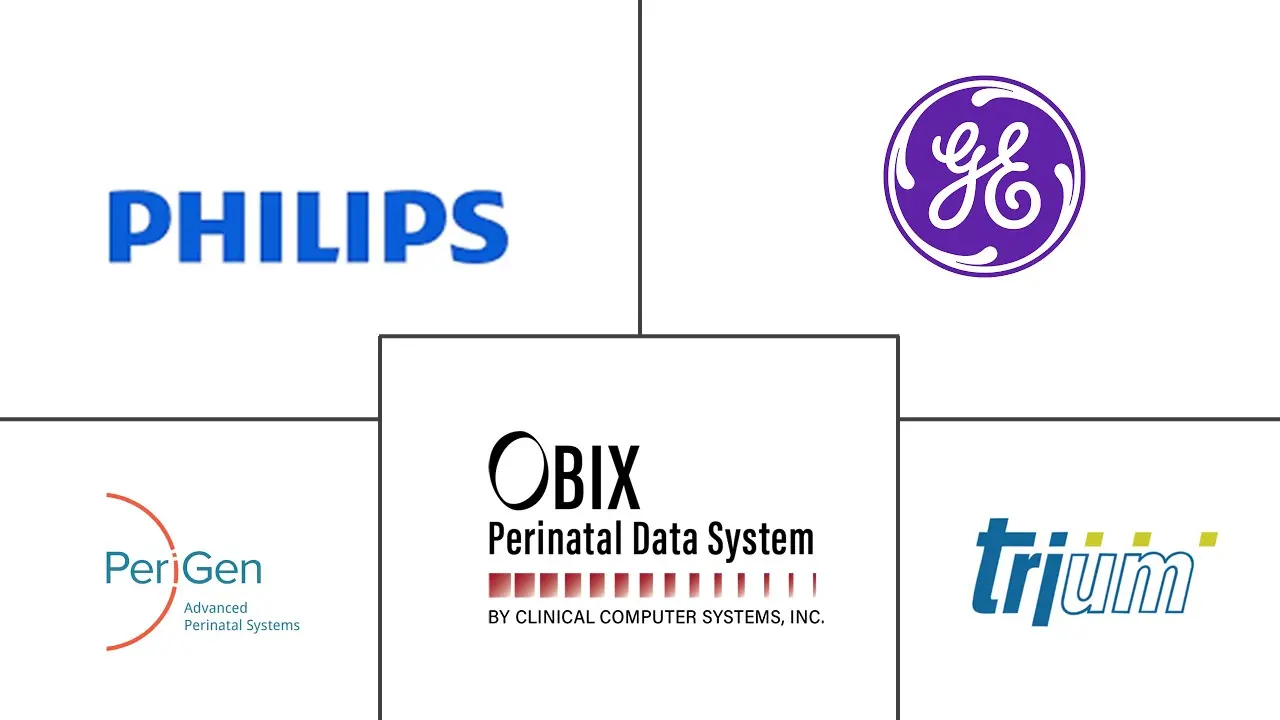
*Disclaimer: Major Players sorted in no particular order |
Clinical Perinatal Software Market Analysis
The Clinical Perinatal Software Market size is estimated at USD 315.06 million in 2024, and is expected to reach USD 525.01 million by 2029, growing at a CAGR of 10.75% during the forecast period (2024-2029).
Clinical perinatal software is an information system that provides advanced technological solutions to examine maternal and fetal health during the perinatal period. The rise in the number of natal mortality and preterm births has increased in the past few years. According to the data published by the United Nations International Children's Emergency Fund in January 2023, 2.3 million infants died in 2021, and nearly 6,400 neonatal deaths occur every day. Preterm birth, intrapartum-related complications, infections, and congenital disabilities are the leading causes of death in most newborns.
Additionally, according to the Pan American Health Organization, in June 2023, out of every ten babies born, one was preterm, and every 40 seconds, one of those babies died. These preterm newborns were found prone to infectious diseases that require constant surveillance using monitoring equipment and software. Thus, these factors have increased the demand for clinical perinatal software, influencing market growth.
Furthermore, technological advancements in clinical perinatal software and the expanding adoption of healthcare IT are promoting the growth of the studied market. Providers in the industry are focused on launching accurate and innovative approaches for monitoring infant and maternal health. They are highly focused on artificial intelligence and other analytical techniques that help analyze maternal vital signs, contractions, fetal heart rate, and labor progression. For instance, in January 2024, Nordic Digital Platforms (NDP), a transformative company bridging the gap between medical innovations and patient well-being, signed a strategic agreement with OBIX, a leading provider of perinatal data systems, to leverage the power of artificial intelligence to transform maternal care services in the United Arab Emirates and the Gulf region. The partnership’s goal is to meet the rising demand for personalized, safe, and convenient maternity care. Such instances are expected to lead to an increase in the use of perinatal software, thereby driving market growth.
Moreover, increased government spending and initiatives to create awareness about prenatal and postnatal care are anticipated to drive market growth in the next five years. For instance, in March 2022, the World Health Organization (WHO) launched its first global guidelines to support women and infants in the postnatal period. The guidelines recommended appropriate care and treatment options for maternity. Meanwhile, in November 2023, the Ministry of Health in Suriname, South America, along with the Pan American Health Organization (PAHO), launched the Perinatal Information System. The new system is integrated with advanced features for monitoring maternal and newborn health. Additionally, the benefits of utilizing perinatal software for pregnancy-related data management propel the market’s growth.
However, budget constraints and the need for extensive training are expected to be significant barriers to market growth.
Clinical Perinatal Software Market Trends
Integrated Segment is Expected to Witness Significant Growth During the Forecast Period
- The integrated segment is projected to experience rapid growth owing to the rising demand among medical experts for continuous workflow integration. Technological advancements integrated with electronic health records (EHR), billing systems, picture archiving and communication systems (PACS), and the adoption of artificial intelligence and data analytics in the system are expected to further drive segmental growth.
- Furthermore, enhanced capabilities of clinical perinatal software have led to more accurate predictions and personalized care plans, thereby increasing its adoption for maternity care. For instance, in January 2024, Pediatrix Medical Group, a US maternity care provider, announced the implementation of Sonio, a cloud-based, AI-powered prenatal care reporting and image management solution. This new technology integrates workflow and enhances quality assurance and clinical outcomes, resulting in an improved experience for both patients and providers. Therefore, the integrated segment is expected to grow significantly during the forecast period due to the abovementioned factors.
- Moreover, increased government funding to develop innovative models integrated with community-based maternal support services dramatically contributes to segmental growth. In September 2023, the US Department of Health and Human Services (HHS) announced that it had awarded more than USD 13.0 million in grants to 11 organizations for its Healthy Families Community-Based Perinatal Health Initiative (COPHI). Its objective is to improve maternity support services for pregnant and postpartum women. Such initiatives highlight the adoption of clinical perinatal software, influencing segmental growth.
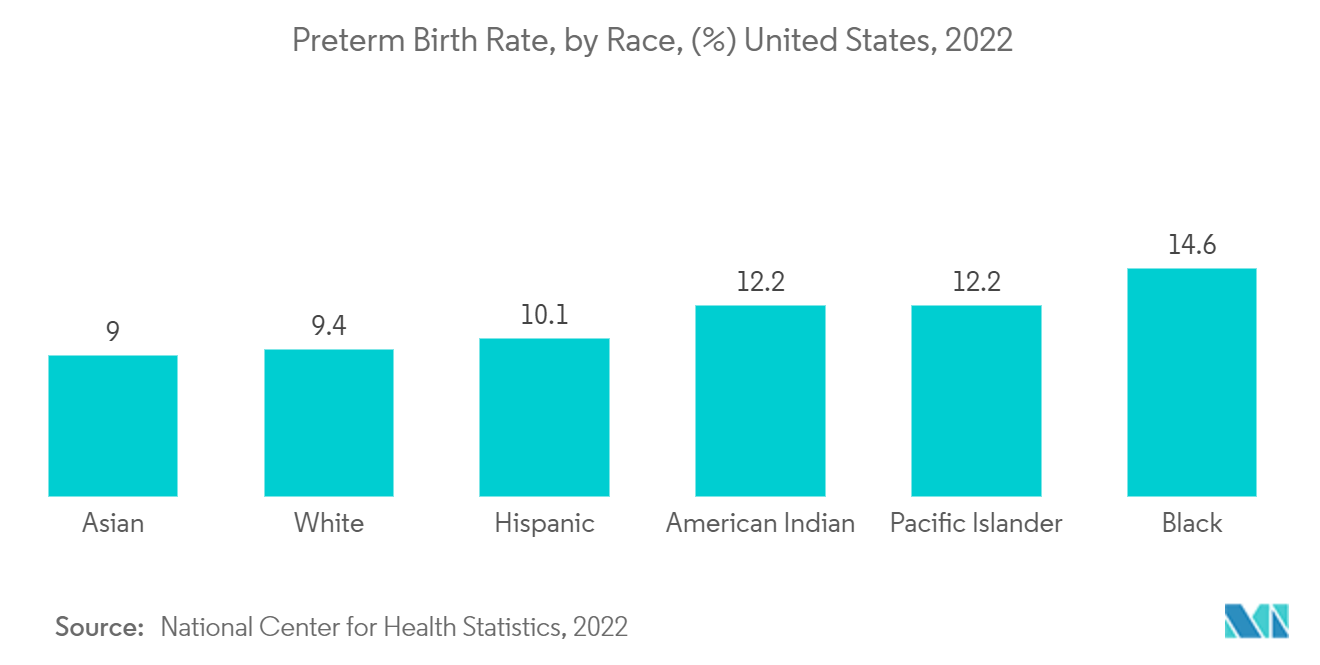
North America is Expected to Dominate the Clinical Perinatal Software Market
- North America accounted for a significant share in 2023. It is anticipated to maintain its position during the forecast period. Factors such as well-structured and developed healthcare systems and high expenditure on healthcare, coupled with the robust research and development activities in these countries, are anticipated to boost market growth in the region. As per the data published by the Centers for Medicare & Medicaid Services (CMS), healthcare spending in the United States is projected to reach around USD 7.2 trillion or nearly 20.0% of gross domestic product (GDP) by 2031. Hence, North America is expected to cover a large share of the clinical perinatal software market.
- Various biological and environmental factors, such as maternal age, smoking habits, obesity, genito-urinary infection, diabetes mellitus, hypertension, alcohol, and illicit drug use, are influencing perinatal birth rates in the region. According to data published by the March of Dimes Organization, during 2020-2022, in the United States, perinatal birth rates were highest for women aged 40 and older compared to women aged below 40. Moreover, as per the data reported by the Ontario Fetal Centre, nearly 8.0% of babies (around 25,000) are born prematurely every year in Canada.
- Additionally, 13.4% and 12.8% of women of childbearing age reported smoking in Mexico and the United States, respectively, in 2022, as per the March of Dimes Organization. Smoking causes long-term effects on health and is a significant factor leading to preterm births. The rise in preterm birth is anticipated to drive the demand for perinatal software, as preterm babies are more susceptible to the above factors. Hence, the market studied is expected to witness significant growth in the region during the forecast period due to the above factors.
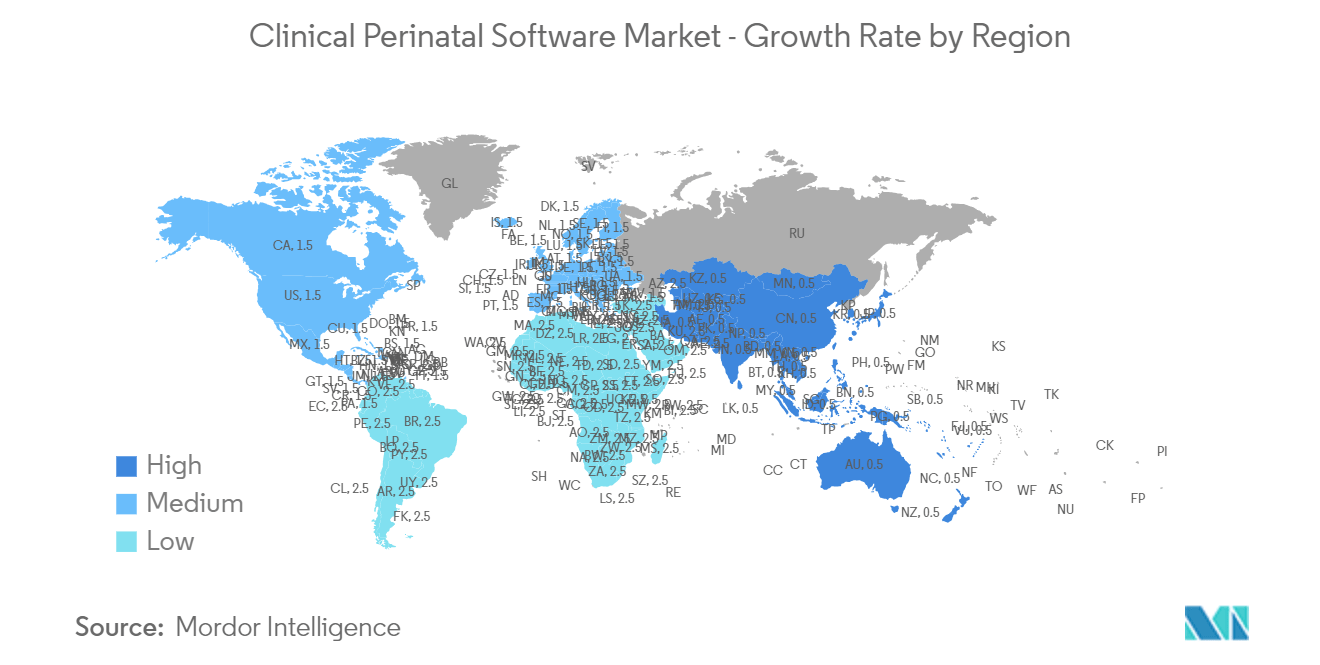
Clinical Perinatal Software Industry Overview
The clinical perinatal software market is moderately fragmented, with most players operating globally and regionally. Prominent players are focused on collaborations and partnerships to provide enhanced maternity care solutions with advanced technologies integrated with artificial intelligence and data analytics. The competitive landscape includes an analysis of a few international and local companies that hold a significant market share and are well known. They include Koninklijke Philips NV, PeriGen Inc., GE HealthCare, Clinical Computer Systems Inc., Trium Analysis Online GmbH, K2 Medical Systems Ltd, AS Software LLC, Huntleigh Healthcare Limited, Sonio SAS, MCKESSON CORPORATION, Glen Med Solutions, and Revvity.
Clinical Perinatal Software Market Leaders
-
Koninklijke Philips N.V.
-
GE HealthCare
-
PeriGen, Inc.
-
Clinical Computer Systems, Inc.
-
Trium Analysis Online GmbH
*Disclaimer: Major Players sorted in no particular order
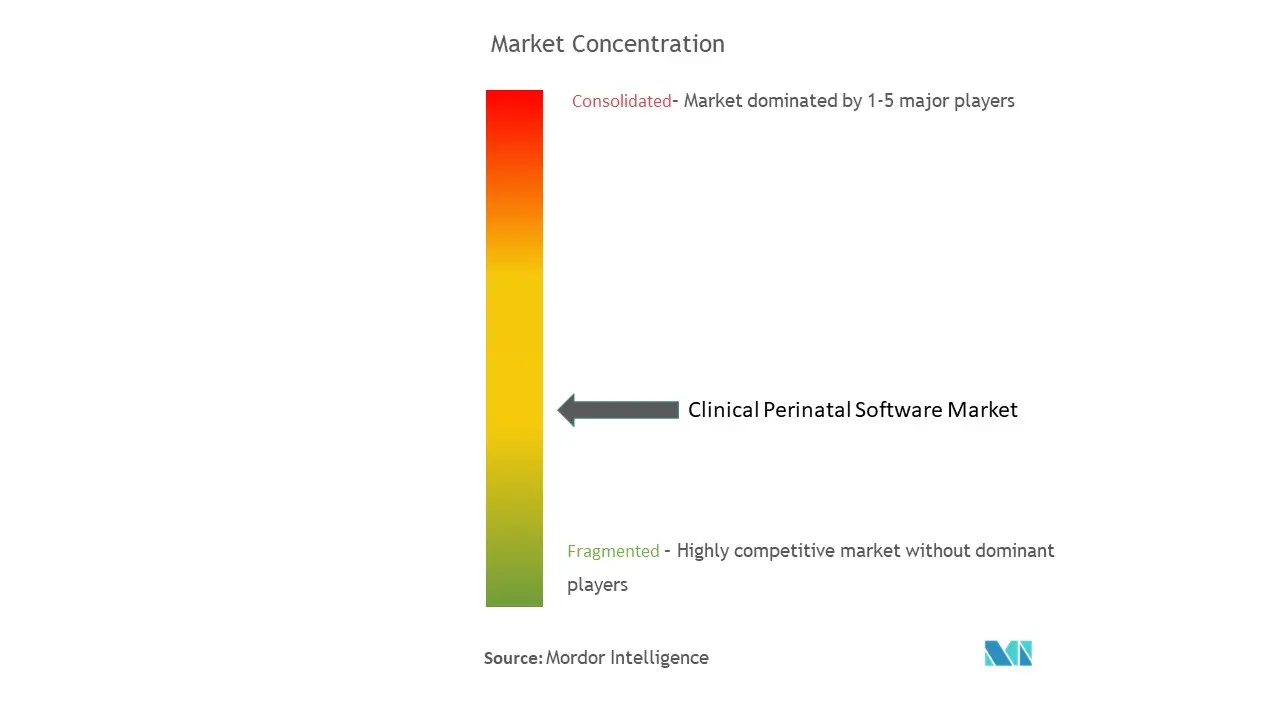
Clinical Perinatal Software Market News
- August 2023: PeriGen Inc., the global leader in AI-powered perinatal care solutions, announced the general availability of LaborWatch following its first successful implementation across a major US health system. The LaborWatch platform employs artificial intelligence (AI)-driven maternal-fetal assessments and escalates persistent issues through automated SMS notifications.
- December 2022: Memora Health Inc., a virtual care delivery and management platform, partnered with PeriGen Inc., a perinatal and prenatal health AI company, to provide healthcare solutions for women. The partnership allows for continued care from labor and delivery to postpartum.
Clinical Perinatal Software Market Report - Table of Contents
1. INTRODUCTION
- 1.1 Study Assumptions and Market Definition
- 1.2 Scope of the Study
2. RESEARCH METHODOLOGY
3. EXECUTIVE SUMMARY
4. MARKET DYNAMICS
- 4.1 Market Overview
-
4.2 Market Drivers
- 4.2.1 Rising Number of Natal Mortality and Preterm Births
- 4.2.2 Increasing Adoption of Artificial Intelligence and Data Analytics in Perinatal Monitoring
- 4.2.3 Growing Government Initiatives & Awareness Regarding Fetal Care
-
4.3 Market Restraints
- 4.3.1 Budget Constraints and the Need for Extensive Training
-
4.4 Porter's Five Forces Analysis
- 4.4.1 Threat of New Entrants
- 4.4.2 Bargaining Power of Buyers/Consumers
- 4.4.3 Bargaining Power of Suppliers
- 4.4.4 Threat of Substitute Products
- 4.4.5 Intensity of Competitive Rivalry
5. MARKET SEGMENTATION (Market Size by Value - USD)
-
5.1 By Product Type
- 5.1.1 Integrated
- 5.1.2 Standalone
-
5.2 By Deployment Mode
- 5.2.1 On-premises
- 5.2.2 Cloud-based
-
5.3 By End User
- 5.3.1 Hospitals
- 5.3.2 Maternity Clinics
-
5.4 By Geography
- 5.4.1 North America
- 5.4.1.1 United States
- 5.4.1.2 Canada
- 5.4.1.3 Mexico
- 5.4.2 Europe
- 5.4.2.1 Germany
- 5.4.2.2 United Kingdom
- 5.4.2.3 France
- 5.4.2.4 Italy
- 5.4.2.5 Spain
- 5.4.2.6 Rest of Europe
- 5.4.3 Asia-Pacific
- 5.4.3.1 China
- 5.4.3.2 Japan
- 5.4.3.3 India
- 5.4.3.4 Australia
- 5.4.3.5 South Korea
- 5.4.3.6 Rest of Asia-Pacific
- 5.4.4 Middle East and Africa
- 5.4.4.1 GCC
- 5.4.4.2 South Africa
- 5.4.4.3 Rest of Middle East and Africa
- 5.4.5 South America
- 5.4.5.1 Brazil
- 5.4.5.2 Argentina
- 5.4.5.3 Rest of South America
6. COMPETITIVE LANDSCAPE
-
6.1 Company Profiles
- 6.1.1 Koninklijke Philips NV
- 6.1.2 PeriGen Inc.
- 6.1.3 GE HealthCare
- 6.1.4 Clinical Computer Systems Inc.
- 6.1.5 Trium Analysis Online GmbH
- 6.1.6 K2 Medical Systems Ltd
- 6.1.7 AS Software LLC
- 6.1.8 Huntleigh Healthcare Limited
- 6.1.9 Sonio SAS
- 6.1.10 MCKESSON CORPORATION
- 6.1.11 Glen Med Solutions
- 6.1.12 Revvity
- *List Not Exhaustive
7. MARKET OPPORTUNITIES AND FUTURE TRENDS
** Subject To AvailablityClinical Perinatal Software Industry Segmentation
As per the scope of the report, clinical perinatal software provides proper management and monitoring solutions for maternal and fetal health during the perinatal period, which includes the time from pregnancy to the immediate postpartum period. The software is integrated with advanced technological features, improving decision-making and patient outcomes. By product type, the market is segmented into integrated and standalone. By deployment mode, the market is segmented into on-premises and cloud-based. By end user, the market is segmented into hospitals and maternity clinics. By geography, the market is segmented into North America, Europe, Asia-Pacific, Middle East and Africa, and South America. The report also covers the market size and forecasts for the clinical perinatal software market in 17 countries across major regions. For each segment, the market sizing and forecasts were made on the basis of value (USD).
| By Product Type | Integrated | |
| Standalone | ||
| By Deployment Mode | On-premises | |
| Cloud-based | ||
| By End User | Hospitals | |
| Maternity Clinics | ||
| By Geography | North America | United States |
| Canada | ||
| Mexico | ||
| By Geography | Europe | Germany |
| United Kingdom | ||
| France | ||
| Italy | ||
| Spain | ||
| Rest of Europe | ||
| By Geography | Asia-Pacific | China |
| Japan | ||
| India | ||
| Australia | ||
| South Korea | ||
| Rest of Asia-Pacific | ||
| By Geography | Middle East and Africa | GCC |
| South Africa | ||
| Rest of Middle East and Africa | ||
| By Geography | South America | Brazil |
| Argentina | ||
| Rest of South America |
Clinical Perinatal Software Market Research FAQs
How big is the Clinical Perinatal Software Market?
The Clinical Perinatal Software Market size is expected to reach USD 315.06 million in 2024 and grow at a CAGR of 10.75% to reach USD 525.01 million by 2029.
What is the current Clinical Perinatal Software Market size?
In 2024, the Clinical Perinatal Software Market size is expected to reach USD 315.06 million.
Who are the key players in Clinical Perinatal Software Market?
Koninklijke Philips N.V., GE HealthCare, PeriGen, Inc., Clinical Computer Systems, Inc. and Trium Analysis Online GmbH are the major companies operating in the Clinical Perinatal Software Market.
Which is the fastest growing region in Clinical Perinatal Software Market?
Asia Pacific is estimated to grow at the highest CAGR over the forecast period (2024-2029).
Which region has the biggest share in Clinical Perinatal Software Market?
In 2024, the North America accounts for the largest market share in Clinical Perinatal Software Market.
What years does this Clinical Perinatal Software Market cover, and what was the market size in 2023?
In 2023, the Clinical Perinatal Software Market size was estimated at USD 281.19 million. The report covers the Clinical Perinatal Software Market historical market size for years: 2019, 2020, 2021, 2022 and 2023. The report also forecasts the Clinical Perinatal Software Market size for years: 2024, 2025, 2026, 2027, 2028 and 2029.
Clinical Perinatal Software Industry Report
Statistics for the 2024 Clinical Perinatal Software market share, size and revenue growth rate, created by Mordor Intelligence™ Industry Reports. Clinical Perinatal Software analysis includes a market forecast outlook for 2024 to 2029 and historical overview. Get a sample of this industry analysis as a free report PDF download.



